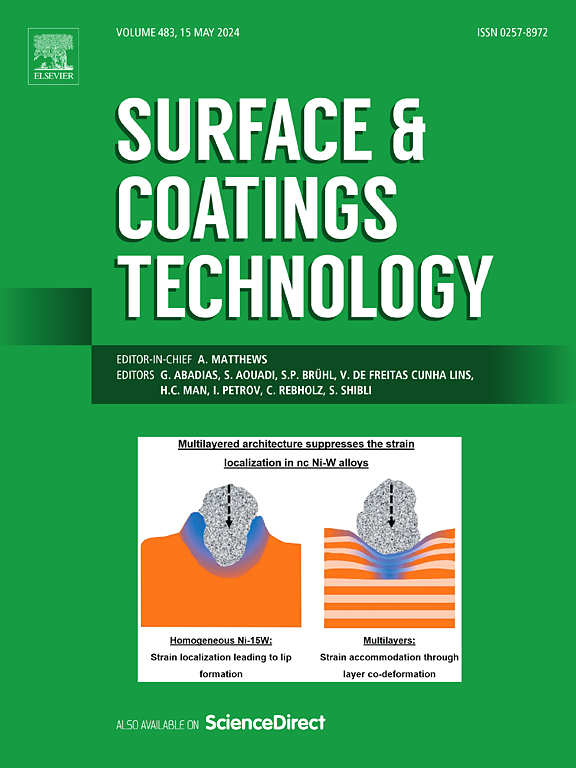Fabrication and erosion performance of Fe-based amorphous/CrN composite coating
IF 5.3
2区 材料科学
Q1 MATERIALS SCIENCE, COATINGS & FILMS
引用次数: 0
Abstract
Via the physical vapor deposition (PVD) technology, CrN coatings were deposited on the high-velocity air fuel (HVAF) sprayed Fe-based amorphous coatings (ACs) to mend their surface defects. The results showed that the incorporation of CrN film can improve the hardness and hydrophobicity of Fe-based ACs because it can seal the surface holes, reduce defects, and improve densification of Fe-based ACs. Meanwhile, the thick and moderately hard Fe-based AC can also support the CrN film and prevent the eggshell effect. Moreover, the CrN coating can improve the hardness of Fe-based AC from 804.55 HV200g to 1104.8 HV200g, as well as reduce the coating surface free energy from 29.15 to 21.13 , the corrosion current density from 2.7 × 10−7 A/cm2 to 0.4 × 10−7 A/cm2, and the mass loss from 0.52 g to 0.41 g in mortar erosion with 50 % sand content. Thereby, the CrN films endow Fe-based AC with enhanced corrosion and erosion resistance. This finding provides a new insight to enhance the corrosion and erosion resistance of Fe-based ACs, thus broadening their potential application in harsh environments.
铁基非晶/CrN复合涂层的制备及其腐蚀性能
采用物理气相沉积(PVD)技术,在高速空气燃料(HVAF)喷涂铁基非晶涂层(ACs)表面沉积CrN涂层,以修补其表面缺陷。结果表明,CrN膜的掺入可以密封铁基ac表面的孔洞,减少缺陷,提高铁基ac的致密性,从而提高铁基ac的硬度和疏水性。同时,较厚、中等硬度的铁基AC也能支撑CrN膜,防止蛋壳效应。此外,CrN涂层可将铁基交流材料的硬度从804.55 HV200g提高到1104.8 HV200g,将涂层表面自由能从29.15 mN·m−1降低到21.13 mN·m−1,腐蚀电流密度从2.7 × 10−7 A/cm2降低到0.4 × 10−7 A/cm2,在含砂量为50%的砂浆侵蚀中,质量损失从0.52 g降低到0.41 g。因此,CrN膜赋予铁基交流电更强的耐腐蚀和抗侵蚀能力。这一发现为增强铁基ac的耐腐蚀和抗侵蚀能力提供了新的见解,从而扩大了它们在恶劣环境中的潜在应用。
本文章由计算机程序翻译,如有差异,请以英文原文为准。
求助全文
约1分钟内获得全文
求助全文
来源期刊

Surface & Coatings Technology
工程技术-材料科学:膜
CiteScore
10.00
自引率
11.10%
发文量
921
审稿时长
19 days
期刊介绍:
Surface and Coatings Technology is an international archival journal publishing scientific papers on significant developments in surface and interface engineering to modify and improve the surface properties of materials for protection in demanding contact conditions or aggressive environments, or for enhanced functional performance. Contributions range from original scientific articles concerned with fundamental and applied aspects of research or direct applications of metallic, inorganic, organic and composite coatings, to invited reviews of current technology in specific areas. Papers submitted to this journal are expected to be in line with the following aspects in processes, and properties/performance:
A. Processes: Physical and chemical vapour deposition techniques, thermal and plasma spraying, surface modification by directed energy techniques such as ion, electron and laser beams, thermo-chemical treatment, wet chemical and electrochemical processes such as plating, sol-gel coating, anodization, plasma electrolytic oxidation, etc., but excluding painting.
B. Properties/performance: friction performance, wear resistance (e.g., abrasion, erosion, fretting, etc), corrosion and oxidation resistance, thermal protection, diffusion resistance, hydrophilicity/hydrophobicity, and properties relevant to smart materials behaviour and enhanced multifunctional performance for environmental, energy and medical applications, but excluding device aspects.
 求助内容:
求助内容: 应助结果提醒方式:
应助结果提醒方式:


